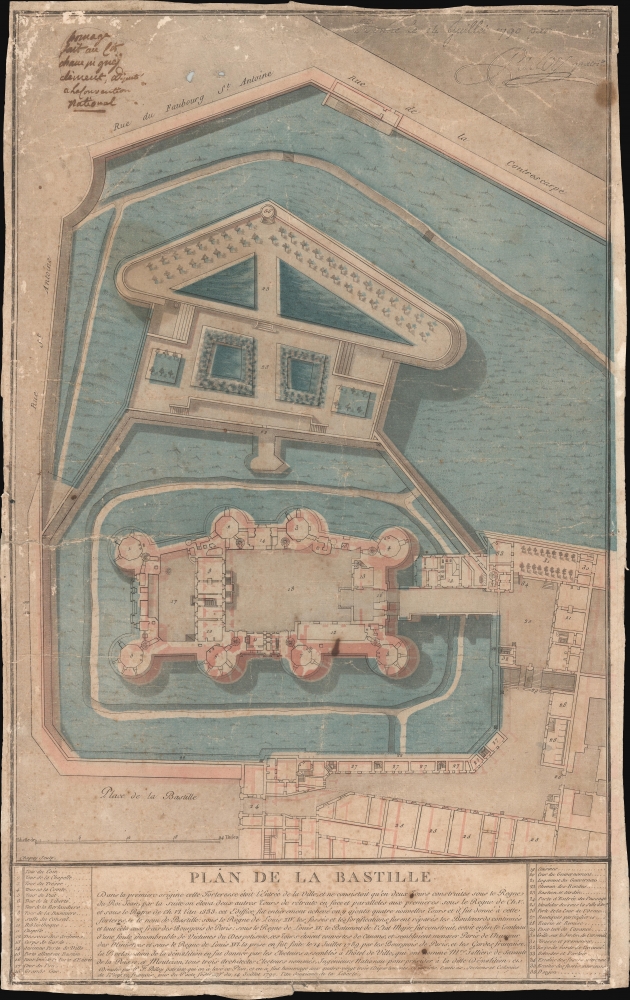Digital Image: 1790 Palloy Plan or Map of the Bastille, Paris, France
PlanBastille-palloy-1790_d
Title
1790 (dated) 21.5 x 13.25 in (54.61 x 33.655 cm)
Description
FOR THE ORIGINAL ANTIQUE MAP, WITH HISTORICAL ANALYSIS, CLICK HERE.
Digital Map Information
Geographicus maintains an archive of high-resolution rare map scans. We scan our maps at 300 DPI or higher, with newer images being 600 DPI, (either TIFF or JPEG, depending on when the scan was done) which is most cases in suitable for enlargement and printing.
Delivery
Once you purchase our digital scan service, you will receive a download link via email - usually within seconds. Digital orders are delivered as ZIP files, an industry standard file compression protocol that any computer should be able to unpack. Some of our files are very large, and can take some time to download. Most files are saved into your computer's 'Downloads' folder. All delivery is electronic. No physical product is shipped.
Credit and Scope of Use
You can use your digial image any way you want! Our digital images are unrestricted by copyright and can be used, modified, and published freely. The textual description that accompanies the original antique map is not included in the sale of digital images and remains protected by copyright. That said, we put significant care and effort into scanning and editing these maps, and we’d appreciate a credit when possible. Should you wish to credit us, please use the following credit line:
Courtesy of Geographicus Rare Antique Maps (https://www.geographicus.com).
How Large Can I Print?
In general, at 300 DPI, you should at least be able to double the size of the actual image, more so with our 600 DPI images. So, if the original was 10 x 12 inches, you can print at 20 x 24 inches, without quality loss. If your display requirements can accommodate some loss in image quality, you can make it even larger. That being said, no quality of scan will allow you to blow up at 10 x 12 inch map to wall size without significant quality loss. For more information, it is best consult a printer or reprographics specialist.
Refunds
If the high resolution image you ordered is unavailable, we will fully refund your purchase. Otherwise, digital images scans are a service, not a tangible product, and cannot be returned or refunded once the download link is used.
Cartographer S
Pierre-François Palloy (January 22, 1755 - January 18, 1835) was a French master mason and public works contractor. Born in Paris, Palloy was raised by his grandfather and attended school in Paris before enlisting in the infantry. After 6.5 years in the infantry, he entered the civilian world in 1775 and began working for an architect-contractor named François Nobillot. He married the architect's daughter in 1776 and secured himself as the architect's successor. By his own account, Palloy owned numerous houses and other buildings around pre-Revolutionary Paris and had a personal fortune he valued at 500,000 livres. After the storming of the Bastille on July 14, 1789, there was considerable debate about what should happen to the building. Palloy knew that he wanted it demolished and began working on it that night under his own initiative. He secured the contract to demolish the prison two days later from the National Constituent Assembly. At one point he had 400 permanent workers on the site and as many as 800 part time workers. Most of the work was done by November and it was completed by July 1790. During and soon after the demolition, Palloy had a series of scale models of the Bastille created using stones from the demolition. These models were delivered to Departmental governments throughout France and numerous other governmental entities, including the city of Paris. George Washington also received a model. Palloy marketed these models under the name 'Palloy Patriote' (Palloy Patriot) and also made medals from the chains used in the drawbridge and to bind prisoners, plans of the Bastille, and other souvenirs. He also used stones from the Bastille to build himself a house in Paris and one in Sceaux. In 1791 he was named a 'Hero of the Revolution.' In 1793 Palloy was accused of embezzling funds from the demolition and was held in prison from December 28, 1793 until March 17, 1794. After being released from prison, Palloy moved to Sceaux where he spent the rest of his life. While living in Sceaux he hosted lavish parties and recounted his stories of the Revolution. Somehow me managed to convince all the succeeding French regimes (the Revolution, Napoleon, the Restoration, and then July Monarchy) that he remained a true patriot. He was awarded the Ordre du Lys in 1814. More by this mapmaker...
Jean-Baptiste Chapuy (1760-18??) was a French engraver. He studied under Janinet and made several engravings in collaboration with him. He made numerous engravings on a variety of subjects throughout the late 18th century and into the early 19th century. Learn More...

